During the time of the U.S. economic challenges, the House Armed Services Committee decided to approve that beginning in 1982, the Reagan administration was allowed to sell government-owned silver to help ease the federal budget gap. Sounds interesting? Learn more about how the American Silver Dollar produced in 1995 helped the U.S. economy.
What Is the 1995 American Silver Dollar Made Of?
The 1995 American Silver dollar, or known as the American Silver Eagle, is the official bullion coin of the United States of America. It has a face value of $1.00, and its composition is 99.9% pure silver and 0.1% copper. This silver bullion has a reeded edge and is struck in the one-troy ounce (31.101 grams). Its diameter is 40.6 mm, and its thickness is 2.98 mm.
When we say bullion coin, it is a coin struck from valuable metals such as silver. These coins are made uncirculated and not used for day-to-day commerce. Being made of precious silver metal and highly valued, the bullion coin is kept as a store of value or investment. So you can use the 1995 American Silver Eagle to fund your retirement plans.
San Francisco, West Point, and Philadelphia were the minting sites that produced the 1995 American Silver Eagle. Coins struck in San Francisco and West Point mints have mint marks, while the Philadelphia coins don’t have mint marks.
The first release of the American Silver Dollar was in November 1986. In the 1980s, the U.S. economy experienced a decline, so the sell-off of silver was legislated to help the government balance its federal budget.
In May 1982, Senator McClure passed the S. 2598 bill stating that the disposal of silver at the Defense National Stockpile Center (DNSC) would be through the issuance of silver coins. This was followed by another bill sent by the Senator in January 1983, the S. 2598 bill, in which the sale of silver from the DNSC would be through silver-mined coins.
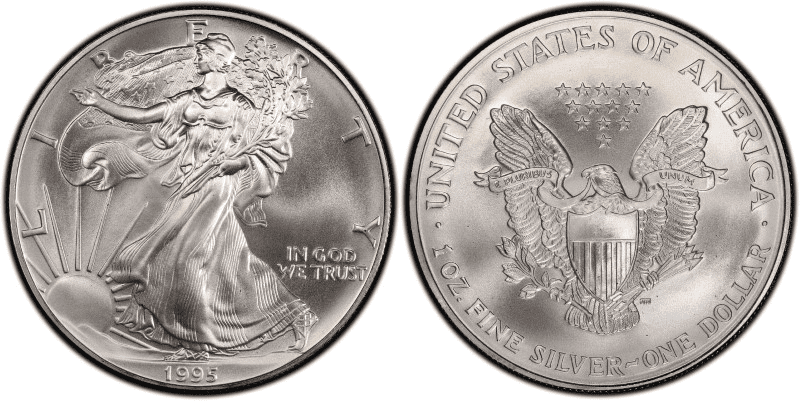
The 1995 American Silver Dollar is widely sought after because its obverse features one of the most beautiful coin designs ever made, i.e. the adoption of Adolph A. Weinman’s “Walking Liberty” design for the Walking Liberty Half Dollar coin series of 1916 to 1947. In addition, you can find these inscriptions on the obverse side of the coin:
- IN GOD WE TRUST
- LIBERTY
- 1995
The reverse, on the other hand, exhibits a heraldic eagle, which John Mercanti designed. The eagle is behind a shield grasping an olive branch on its right talon and arrows on its left talon, symbolizing the U.S. Great Seal.
Also, you can see thirteen five-pointed stars representing the Thirteen Colonies above the eagle. The following inscriptions are also included:
- UNITED STATES OF AMERICA
- 1 OZ. FINE SILVER~ONE DOLLAR
- E PLURIBUS UNUM is written on the eagle’s banner in its beak
- A mint mark for Proof coins
The overall design of the American Silver Dollar is traditional yet elegant. It is also highly recognized because of the “1OZ FINE SILVER” inscription, which doesn’t appear on other designs of bullion coins.
1995 American Silver Dollar Varieties
Since 1986, there’s been a massive production of the American Silver Eagle, becoming one of the most widely recognized bullion coin series worldwide. In particular, the 1995 series were produced at the three U.S. mints. It has two versions: Bullion and Proof coins with varieties: 1995-S, 1995-W, and 1996-Proof.
1995 was also a commemorative year, as this was the 10th anniversary of the coin. This occasion prompted the mint in West Point to create special American Silver Eagle proof coins apart from the usual uncirculated and the Philadelphia proof versions.
The three mints produced 5.1 million 1995 American Silver Eagle coins from bullion, proof, and the special 1995-W proof.
1995 S American Silver Dollar
Year of minting: 1995
Mint Mark: No mint mark
Minted in: San Francisco
Quantity produced: 1,781,132
Face Value: $1.00 (one dollar)
Price: Approximately $42 Uncirculated MS65 condition
Mass: 31.101 grams (1 oz)
Edge: Reeded
Designer: Adolph Weinman/John Mercanti
Composition: 99% Silver and 1% Copper
Diameter: 40.6 millimeters
Thickness: 2.98 millimeters
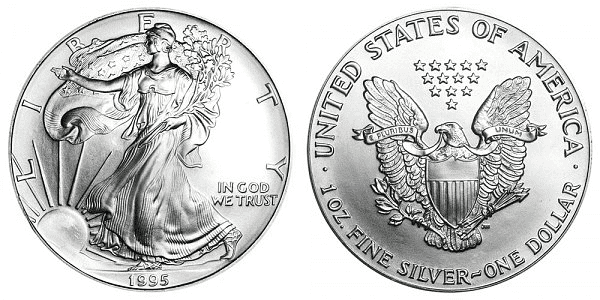
More than 1.7 million American Silver Dollar coins were produced at the San Francisco Mint in 1995. Plenty of these are still searchable and carry a small premium. You can still find MS68 in this variety.
1995 W American Silver Dollar
Year of minting: 1995
Mint Mark: No mint mark
Minted in: West Point
Quantity produced: 2,890,919
Face Value: $1.00 (one dollar)
Price: Approximately $42 Uncirculated MS65 condition
Mass: 31.101 grams (1 oz)
Edge: Reeded
Designer: Adolph Weinman/John Mercanti
Composition: 99% Silver and 1% Copper
Diameter: 40.6 millimeters
Thickness: 2.98 millimeters

The mint in West Point produced over 2.8 million 1995 American Silver Dollars. Interestingly, only a few coins in the 1995-W variety are available, making it the most expensive coin in the set.
1995 American Silver Dollar Proof
Year of minting: 1995
Mint Mark: P
Minted in: Philadelphia
Quantity produced: 438,511
Face Value: $1.00 (one dollar)
Price: Approximately $99 in PR65 condition
Mass: 31.101 grams (1 oz)
Edge: Reeded
Designer: Adolph Weinman/John Mercanti
Composition: 99% Silver and 1% Copper
Diameter: 40.6 millimeters
Thickness: 2.98 millimeters
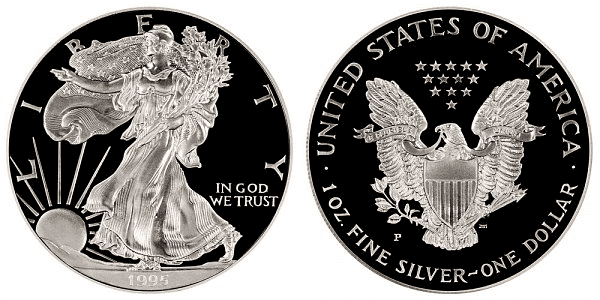
In 1995, just 438,511 proof American Silver Eagle coins were made at the Philadelphia Mint. This variety has a similar rarity to other common American Silver Dollar proof coins. You would know that this is the standard proof coin minted in 1995 because of its “P” mint mark. Some bullion collectors sell 1995 American silver dollars for as much as $150.
1995 W American Silver Dollar (Proof)
Year of minting: 1995
Mint Mark: W
Minted in: Westpoint
Quantity produced: 438,511
Face Value: $1.00 (one dollar)
Price: Approximately $3,716 in PR65 condition
Mass: 31.101 grams (1 oz)
Edge: Reeded
Designer: Adolph Weinman/John Mercanti
Composition: 99% Silver and 1% Copper
Diameter: 40.6 millimeters
Thickness: 2.98 millimeters
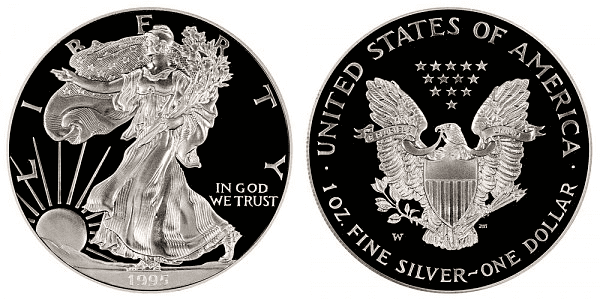
As mentioned earlier, 1995 is the 10th anniversary year of the American Silver Dollar. So to celebrate this occasion, the West Point mint was assigned to produce 30,125 special 1995-W-proof American Silver Eagle coins. This version has a “W” mint mark and was only sold in sets. These 1995-W proofs are rare nowadays, with a high premium of above $10,000 for a perfect certified version.
List of 1995 Silver Dollar Errors
There are few widespread errors for the bullion coins as the mints put systems in place to stop significant errors during minting. Nevertheless, with the massive production, errors are still occurring for these uncirculated versions of the American Silver Dollar coins, particularly for the series of 1995.
Take a look at a sample below:
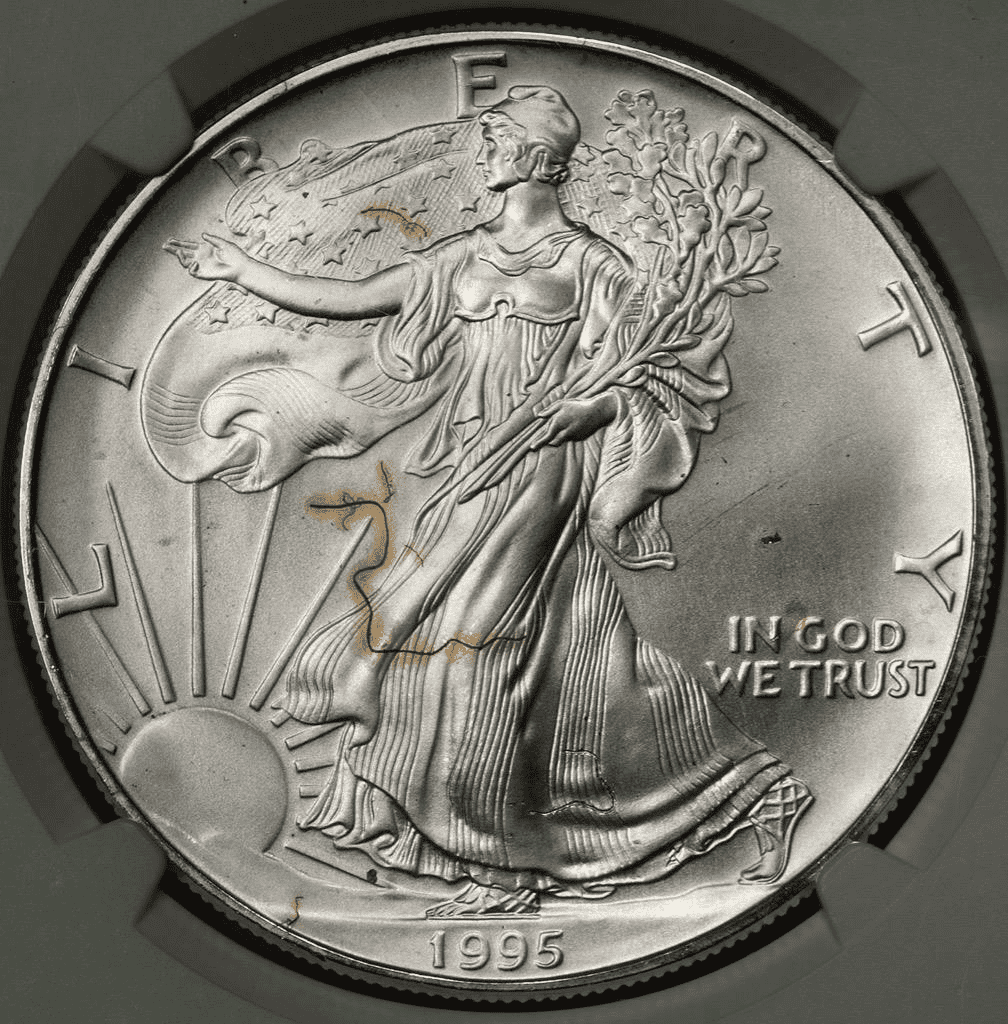
Due to the uniqueness of an error coin, it is usually worth a premium when sold. The 1995 American Silver Eagle is also not spared from common mint errors like planchet, strike, or die errors.
How Much Is the 1995 Silver Dollar Worth Today?
As usual, those coins with the lowest mintage are the most valuable. The 1995 American Silver Dollar production is the fourth lowest among the series, so it’s no wonder it’s worth a premium.
The price of a coin depends on its year of minting, mintage, details, and condition. As for its melt value, it’s based on the value of silver metal per ounce in the current market. Today, the melt value for the 1995 American Silver Dollar is $22.4827.
How Does The Grading System Work?
Professional numismatists joined in the 1970s and established CoinGrading standards, known as the Sheldon Scale. These numismatists now assign grades at key places on the seventy-point scale, using the most regularly utilized numeric points in conjunction with the original adjective grade. The following are the most common coin grades:
- (P-1) Poor – Indistinguishable and probably damaged; if used, must have a date and mintmark; otherwise, rather battered.
- (FR-2) Fair – Nearly smooth, but without the damage that a coin graded Poor often possesses. The coin must have enough detail to be identified.
- (G-4) Fair – Inscriptions have merged into the rims in some areas, and important elements have been mostly erased.
- (VG-8) Very Good- A little weathered, but all primary design elements are visible, albeit faintly. There is little, if any, central detail left.
- (F-12) Good – The item is very worn, yet the wear is even, and the overall design details stand out clearly. Rims are almost completely isolated from the field.
- (VF-20) Very Fine – Moderately weathered, with some finer features still visible. The motto or all letters of LIBERTY are readable. Both sides of the coin have entire rims separated from the field.
- (EF-40) Extremely Fine – Gently used; all gadgets are visible, and the most important ones are bold. The finer details are bold and clear; however, light wear may be seen.
- (AU-50) Uncirculated – Slight evidence of wear on the coin’s design’s high points; it may have contact marks; eye appeal should be adequate.
- (AU-58) Uncirculated Choice – Slight traces of wear, no severe contact marks, almost full mint shine, and great eye appeal.
- (MS-60) Mint State Basal – Strictly uncirculated; no indication of wear on the coin’s highest points, but an unsightly coin with reduced luster, visible contact marks, hairlines, and other flaws.
- (MS-63) Mint State Acceptable – Uncirculated, but with contact scratches and nicks, little reduced shine, but otherwise appealing appearance. The strike is weak to average.
- (MS-65) Mint State Choice – Uncirculated with great mint shine, little contact blemishes, and exceptional eye appeal. The strike is unusually severe.
- (MS-68) Mint State Premium Quality – Uncirculated with superb luster, no obvious contact marks to the naked eye, and exceptional eye appeal. The strike is quick and appealing.
- (MS-69) Almost Perfect Mint State – Uncirculated with perfect brilliance, a sharp and appealing strike, and extremely good eye appeal. A near-perfect coin with minor imperfections in the planchet, strike, and contact markings (seen only under 8x magnification).
- (MS-70) Mint State Perfect – Under 8x magnification, no tiny imperfections are discernible; the strike is crisp, and the coin is perfectly centered on a beautiful planchet. Rarely seen on a coin, this coin is bright and whole, with original luster and exceptional eye appeal.
Suppose you want to know the grade of your 1995 American Silver Eagle collections; it would be best to bring them to professionals from credible agencies like the PCGS, NGC, ICG, and ANACS. They are known for their unbiased evaluation of coins and other valuable collectibles.
Where to Buy or Sell the 1995 Silver Dollar?
It is guaranteed to find quality bullion coins like the 1995 American Silver Eagles from renowned coin sites like JM Bullion, NGC, PGCS, USA Coin Study, etc. In addition, they can give you more insights in terms of the coin’s price and grade.
Online stores are also a way to buy and sell your bullion coins. Of course, you can always go to an auction house to get a good collection value. Remember that 1995 American Silver dollars are made of pure silver, so going to investment houses would also be a good decision.
FAQs
Where is the mint mark on a 1995 silver dollar?
There is no mint mark for the 1995 American Silver bullion coins, while the “P” mint mark is found on the reverse side of the proof coins. This indicates that the coin is made in Philadelphia. Interestingly, the special coins produced for the 10th anniversary of the American Silver Dollar have “W” mint marks on the reverse or tail side.
How much is a 1995 silver dollar worth today?
Depending on its condition, uncirculated 1995 American Silver Eagle bullion could be worth approximately $40 to $100, while proof coins are priced at thousands of dollars.
What is a 1995 1 oz fine silver dollar worth?
The weight of silver would determine the value of 1-ounce silver in the 1995 American Silver Eagle. At the current market value, the spot price of silver is a little over $22 per ounce.
